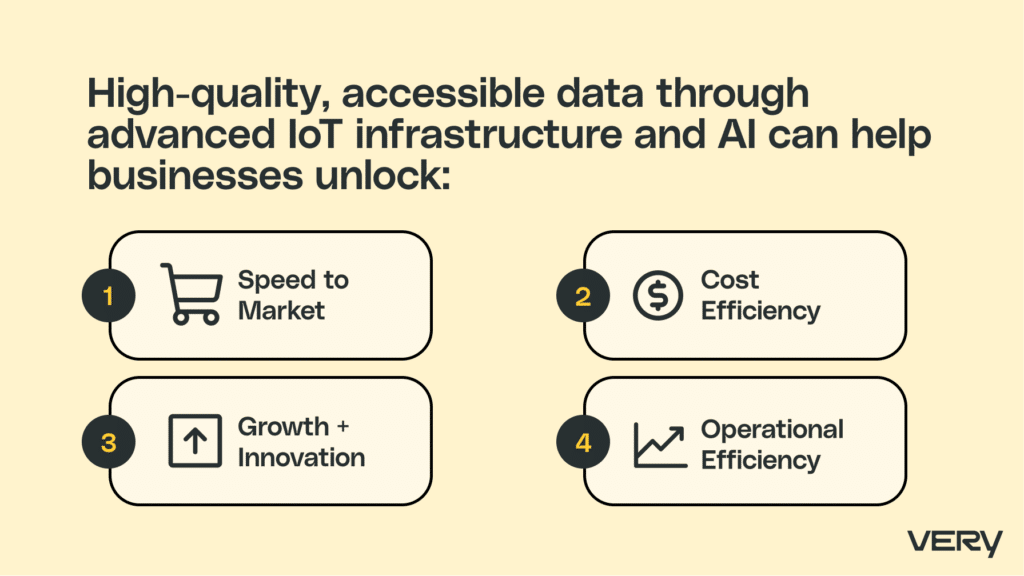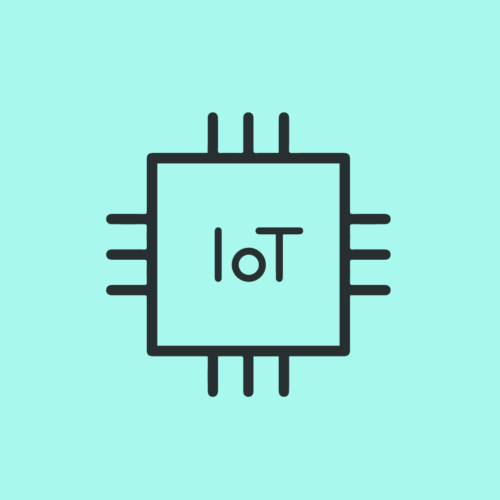BLOG
Data + AI: The Engine of Modern Growth
You’ve likely heard the phrase “knowledge is power,” and nowhere is this truer than in today’s data-driven world. Just like a car can’t run without fuel, the AI boom wouldn’t be possible without vast quantities of high-quality data.
To fully understand and optimize your business, you need to infuse it with sensors and build a comprehensive Internet of Things (IoT) infrastructure—your very own Enterprise Data Platform. This setup is like a finely tuned orchestra, where each instrument plays its part to create a harmonious performance, tailored to your unique business environment.
Valuable Data-Driven Outcomes
When it comes to fueling AI, three elements are essential: the number of data points, the dimensionality of the data, and the reliability of the data. Back in the day, our early models worked great on textbook problems but fell apart in the real world. We quickly learned that we needed more dimensions, more information, to capture the phenomena we were modeling accurately. But as we added more data, the curse of dimensionality kicked in, demanding exponentially more data points. And let’s not forget about data reliability—human labeling, for instance, can be notoriously inconsistent. For AI models to tackle real-world problems, they need a treasure trove of reliable, high-dimensional data, especially for training models with thousands, millions, or even trillions of parameters like GPT-4.
Data Accessibility: Fueling AI Advancements
Data accessibility is the oil that keeps the AI engine running smoothly. There are two main contexts here: domain-specific applications and deep learning models. In domain-specific areas like predictive maintenance, you need a solid data infrastructure to connect and expose data from multiple sources, providing the necessary high dimensionality. For deep learning models, data accessibility involves both training data and pre-trained foundational models. Thanks to platforms like HuggingFace, you can access thousands of hours of training data and pre-trained models, eliminating the need to start from scratch and accelerating your AI development.

Components of Successful Outcomes
Sensors: Optimizing Business Operations
When optimizing your business, remember: sensors are your best friends. They’re the primary data generators for machine learning processes. Initially, your predictions might be off, often because you need more information or dimensions. This could mean tapping into adjacent systems or strategically installing more sensors. Over time, a well-deployed sensor network can significantly enhance your operational efficiency by providing a comprehensive view of your processes.
Key Components of a Complete IoT Infrastructure
Imagine your IoT infrastructure as a smart city, with five main components working together:
- Fleet of Nodes: These are the low-powered microcontrollers that sense and control end devices.
- Gateway: It connects the nodes to the cloud, often using technologies like LoRa.
- Cloud Platform: This ingests and stores data, manages devices, responds to events, and interfaces with users.
- AI Platform: Essential for training, deploying, and monitoring machine learning models.
- Mobile App: Provides direct connectivity for provisioning and debugging, and gives users a real-time view of the system from the cloud.
Customizing IoT Infrastructure for Unique Environments
As you adapt your IoT infrastructure, consider three big factors: power, latency, and connectivity. Often, nodes need to be battery-powered, which drives energy-efficient design and real-time operating systems (RTOS). Latency is another critical factor—how quickly does your system need to react? If response time is crucial, more computation needs to happen on the node. Connectivity also plays a significant role; many environments require robust wireless solutions due to limited access to traditional power sources or network infrastructure.
Multidisciplinary Approach in IoT Systems
IoT systems are like a symphony, requiring seamless collaboration between various disciplines. Start with product and system design to understand the needs of all stakeholders. Hardware engineering comes next, involving custom components and firmware development. Software teams handle data ingestion, storage, and application development. Finally, data scientists work across these teams to deploy intelligence throughout the system.
Enhancements
Enhancing IoT Performance with AI and Edge Computing
AI and edge computing enhance IoT performance by balancing costs, latency, and accuracy. Imagine you’re deploying a machine vision model—data processing can happen on the node, minimizing latency, or in the cloud, maximizing model performance. The optimal system usually strikes a balance between these extremes, ensuring efficient, real-time processing and decision-making.
Cost and Security Benefits of AI in IoT
When you push AI to the edge, you reduce communication and cloud computing costs while enhancing security. With less data transmitted, you minimize in-transit risks and limit the impact of potential breaches. This is crucial for sensitive data like voice recordings, images, or medical information, ensuring privacy and compliance with regulations.
Evolving Wireless Solutions for Modern Businesses
The world of IoT wireless solutions is rapidly changing, improving range, bandwidth, and coverage. Innovations like satellite IoT and NB-IoT in 5G are transforming connectivity for remote systems in industries such as power generation, mining, and agriculture. Mesh networks, too, are becoming more reliable, ensuring seamless communication in challenging environments.
Challenges and Opportunities with Wireless Connectivity
The biggest challenges in wireless connectivity are communication costs and potential connectivity loss. Robust IoT systems must operate effectively without an active connection and re-sync once connectivity is restored. The primary opportunity lies in the flexibility to deploy devices anywhere, providing unprecedented levels of insight, control, and operational flexibility.
Final Thoughts
Data is still the engine driving modern growth. By leveraging high-quality, accessible data through advanced IoT infrastructure and AI, businesses can optimize operations, reduce costs, and drive innovation. Embracing a multidisciplinary approach ensures seamless integration and performance of these complex systems, paving the way for a smarter, more connected future.
At Very, We specialize in expert IoT system design that makes your data capture secure and analysis actionable with the help of world class UX and AI powered enhancements to achieve transformative outcomes.
Ready to turn your device data into your most valuable asset? Let’s define and deliver the results that matter most to you.









